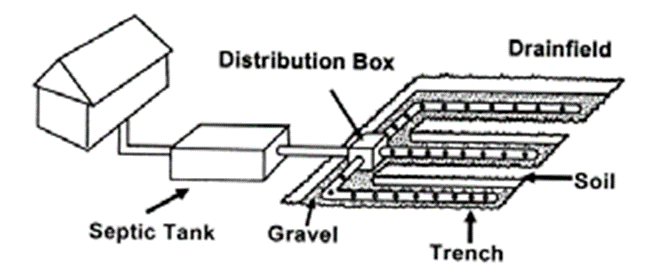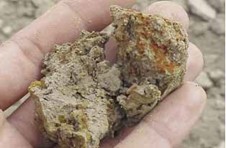Septic Drain Field Design and Maintenance
Septic Drain Field Design and Maintenance
Definition
Septic drain fields are subsurface systems that recycle human wastewaters. Properly designed systems transmit and store the household effluent below the surface and allow soils and microorganisms to clean the wastewater before returning it to the hydrologic cycle.
Purpose
The entire septic system serves as an onsite, household-sewage-treatment system. The drainfield keeps human waste below ground, away from human contact, which reduces the risk of nutrient and disease-causing pathogens from reaching water bodies.
How Does This Practice Work?
A conventional septic system is composed of three parts: a septic tank, drainfield and soil (Fig. 1). The liquid and solid household waste flows into a septic tank, which is typically below ground. The septic tank primarily functions as a separation chamber and an anaerobic digester. Solid material denser than water sinks to the bottom, and less dense material (i.e., fats, oils) float to the top. Liquid in the middle of the tank (septic tank effluent) exits the tank and flows to the drainfield.

Typically, the drainfield consists of three to five trenches that are 18 to 24 inches deep, up to 100 ft long, with a perforated pipe in 12 to 18 inches deep gravel covered by 12 inches of soil. A properly designed drainfield should distribute wastewater over a large enough area to allow it to infiltrate into the soil for treatment. A distribution box is often used to accomplish equal distribution across trenches.
The soil acts as a natural filter and contains organisms that help treat the wastewater. The nutrients, such as phosphorus (P), in the wastewater are adsorbed or chemically bonded to the soil particles, which limits P mobility. The pathogens in the wastewater are typically destroyed by filtration and the natural populations of soil microorganisms.
The septic drainfield must be properly sized to the soil conditions at each location. Each soil should get a thorough examination by a professional prior to installation. There must be a uniform brown to red soil colors (indicating well-drained conditions) in the area where the drainfield is located. Infiltration is inferred from the soil texture. A perched seasonal water table is determined by observing the color and uniformity of colors in the soil. A grey-colored soil or a soil that has grey mottles (spots) indicates standing water during the wet season.

Where This Practice Applies and Its Limitations
Drainfields will function properly in a wide range of soils in all climatic regions within the U.S. Septic systems are required in areas where municipal wastewater treatment systems are not available.
There are limitations to these systems. Drainfields will not function hydraulically in high clay soils, shallow soils, or soils with a perched seasonal water table. The high-clay soils will not allow the wastewater to infiltrate fast enough to remain below the soil surface. On the contrary, soils with extremely high sand content or shallow depth to bedrock do not renovate the wastewater before reaching the aquifer. The soils with a perched seasonal water table near the surface will fill with natural rainwater at some times during the year and will not have the capacity to accept additional wastewater. This will cause the wastewater to surface, where it will run off into streams or may come into direct contact with humans.
In some cases, alternative designs that involve pre-treatment of wastewater prior to reaching a drainfield may be acceptable if the soil does not provide proper renovation.
Effectiveness
With a properly designed septic system, the wastewater will remain below the soil surface, where it will contact microorganisms and soil complexing agents to be properly renovated and returned to the hydrologic cycle. However, P removal by adsorption/precipitation is highly dependent on the media capacity. The total P concentration in wastewater averages 1-2 g/person/day; however, the data analysis of wastewater through soils is limited and ranges from 0 to 100 percent removal.
Keep in mind that approximately 25% of the US population utilizes septic systems. According to Census data, about 10% of these systems fail.
Cost of Implementing the Practice
The laws vary from state-to-state. However, the same general guidelines apply. Prior to constructing a septic system and drainfield, a permit from the local or state department of public health is commonly required. Apart from the septic system material, such as a septic tank, pipe and gravel, a certified or licensed professional must evaluate the soil and provide a design. Then, a certified or licensed septic system installer must be hired.
With a conventional system (septic tank, drainfield, trench), the average cost of materials and installation is low at a few to several thousand dollars. However, when soils are limiting, alternative systems must be used, and the cost can easily exceed tens of thousands of dollars for installation. These complex systems also require regular inspection and maintenance.
Operation and Maintenance
Proper drainfield function requires septic effluent with a minimum amount of solid material; therefore, the septic tank should be cleaned out every 7 to 10 years. If the septic tank overfills and solid materials begin exiting the tank with the wastewater, the solids will cause a decrease in the soil’s permeability, and the drainfield will fail due to surfacing septic effluent.
Limiting the flow of water from the household may also be helpful. To lessen water flow, lowflush toilets and other water-conserving measures are commonly used. In alternative systems, yearly maintenance contracts are commonly required by the regulatory agency prior to approval.
Avoid driving or parking over the septic drainfield. Heavy vehicles may crush the pipes within the drainfield. Also restrain from flushing non-degradable objects or hazardous chemicals down the toilet. These items clog your system and disrupt the microbiological treatment of the waste.
Trees or shrubs over the drainfield can cause problems due to root intrusion. Woody plants have extensive root systems, which seek out the nutrient-rich water, and thus may clog the system. Also, do not build structures over the field or cover the field with hard surfaces such as asphalt.
Divert surface water runoff sources (i.e., downspouts) away from the drainfield. Excess water on the drainfield limits the soil capacity to renovate septic tank effluent.
There is no evidence that septic tank additives improve the performance of septic systems. Additives are costly and may be harmful to the system.
References
Angoli, T. 2001. Summary of the Status of Onsite Wastewater Treatment Systems in the United States During 1998. In Proceedings of the Ninth National Symposium on Individual and Small Community Sewage Systems. ASAE, St. Josephs, MI.
Siegrist, R.L. 2001. Advancing the Science and Engineering of Onsite Wastewater Systems. In Proceedings of the Ninth National Symposium on Individual and Small Community Sewage Systems. ASAE, St. Josephs, MI.
USEPA. 2002. Onsite Wastewater Treatment Systems Manual. STP EPA/625/R-00/008. Washington, DC.
For Further Information
The local Department of Health or similar state agency must be contacted for a permit prior to septic system installation. These local and state agencies maintain a list of licensed septic system providers.
Current Authors
| Brad D. Lee University of Kentucky brad.lee@uky.edu |
Phillip R. Owens USDA-ARS phillip.owens@usda.gov |
Editing and Design
| Deanna Osmond NC State University |
Forbes Walker University of Tennessee |
Citation:
Lee, B. and P. Owen. 2023. Septic Drain Field Design and Maintenance. SERA17 Phosphorus Conservation Practices Fact Sheets. https://sera17.wordpress.ncsu.edu/septic-drain-field-design-and-maintenance/
